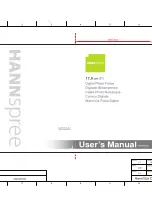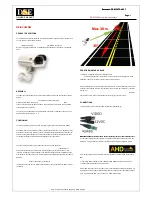
Cheetah Pregius Camera with GigE Vision
®
Interface – User Manual
August 27, 2019
Page
106
of
123
Rev 1.0
5.8 Input / Output Control
Some camera models support two inputs and two outputs (one TTL and one opto-isolated
output), others may have only one input and one output (both opto-isolated). Refer to the
for the inputs and outputs supported by different camera models.
You can map an external trigger signal to either input 1 or input 2 by setting Trigger Source
parameter to “Line 1” or “Line 2” respectively (also see
you can select what edge (rising or falling) will be used for triggering.
The inputs have debounce and filter options to prevent false triggering. The Trigger filter
option defines the input trigger signals minimum pulse width. By setting the Trigger filter
setting to a value slightly less than the input signal’s pulse width, the camera will reject any
noise with pulse widths less than the Trigger filter setting.
The debounce option defines the time period following a triggering event in which no
additional triggers will be accepted by the camera.
You can map up to fourteen signals to either output 1 or input 2 by setting OutputSelector
parameter to one of them (refer to the section
5.10 Strobe and Synchronization Controls
For each mapped signal you can select active High or active Low.
5.9 Camera Triggering
Trigger Modes
The camera supports Standard and Fast Trigger modes.
In
Standard
trigger mode
, the camera first performs the exposure (using the internal timer or
external pulse width) and then reads out the image. The minimum trigger period is equal to
the maximum exposure time plus the camera readout time.
In
Fast trigger mode
, the exposure period and readout period are overlapped in a way that is
similar to free-running (untriggered mode). Fast trigger mode depends upon a constant and
stable trigger source so the camera can position the exposure period to conclude just as the
previous frame readout ends. If the trigger period varies, the exposure will vary with the
trigger period and uneven image illumination or wavering image brightness will result.
Trigger Sources
In the normal mode of operation, the camera is free running, which means the camera
continually reads out the sensor. If using a trigger to initiate readout, trigger mode enables
synchronizing the camera to a timing pulse.
The camera offers four sources for triggering: external Line1 or Line2, internal (pulse
generator), and software. You can select the trigger input to a corresponding camera input.
•
Line 1
– hardware Input Line GP IN 1 (TRIGGER 1) is used as external source for the
trigger signal.
•
Line 2
– hardware Input Line GP IN 2 (TRIGGER 2) is used as external source for the
trigger signal (Line 2 is not available in C2000, C2400, and P67 cameras as they have
only one input).
•
Pulse Generator
– trigger source is generated by camera's internal Pulse Generator.
















































